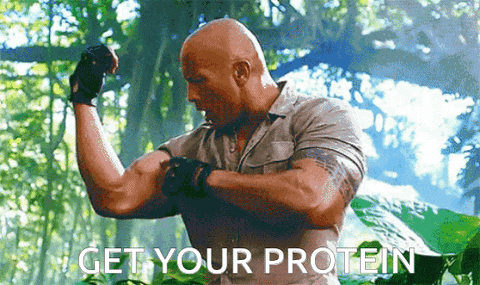Is There Such a Thing As Too Much Protein?

We spend a lot of time talking about the wacked out food pyramid and looking at energy and macros, but is there such a thing as too much protein?
Contents
2. How much protein do you need?
Key Points
- Protein creates the building blocks for our muscles.
- Eating too little protein is much more dangerous to your body than eating too much.
- Most adults don't hit their general protein mark daily, so you probably don't need to worry about over-consuming protein.
What does protein do?
To better answer this question, understanding protein and its role in our body is important. Protein, lipids, and carbs are the three macronutrients. Macronutrients supply energy in the form of calories. Protein is a macronutrient that is required for muscular growth. It is most typically found in animal products, but it can also be found in nuts and legumes.
Chemically, protein is composed of amino acids, which are organic compounds made of carbon, hydrogen, nitrogen, oxygen or sulfur. Amino acids are the building blocks of proteins, and proteins are the building blocks of muscle mass. Amino acids are also crucial in the construction of neurotransmitters, if you don’t have enough, it will cause changes in your mood.

While it could be a problem to have too much protein, having too little protein is far worse for your mental and physical health. Some other negative side effects of too little protein are:
- Brittle hair and nails
- Flaky skin
- Weakness and fatigue
- Slow healing injuries
- Getting and staying sick
- Weakened immune system
How much protein do you need?
Protein should account for 10–35 percent of your total calories, according to general guidelines.
Adults who are physically active may require 1.2–1.7 grams (g) per kilogram (kg) of body weight per day. For a 150-pound person, this translates to 82–116 grams. The official recommended daily allowance (RDA) for healthy people is 0.8 grams of protein per kilogram of body weight per day, which corresponds to 54 grams of protein for a 150-pound person.

Protein-rich diets aid in the reduction of hunger, the rise of satiety, the increase of metabolic rate, and the preservation of muscle mass. Diets, on the other hand, are not one-size-fits-all, and what works for one person may not work for another. Today there are a few popular high protein diets, mainly for people trying to either lose weight, gain muscle or both. Here is a list of the most popular:
- The Atkins Diet - Created by Dr. Robert Atkins in 2001, the Atkins Diet has 27 percent protein, 5 percent carbs, and 68 percent fat.The Atkins Diet includes all sorts of protein and fat, such as meat, fish, chicken, eggs, cheese, butter, and oil, while restricting carbohydrates such as bread, pasta, fruit, milk, alcohol, and starchy vegetables such as potatoes, peas, and corn. The Atkins Diet's high fat content can be harmful to one's heart. Colon cancer, renal impairment, bone loss and ketoacidosis (a condition that causes dizziness, weakness and irritability) are all hazards connected with the Atkins Diet.
- The South Beach Diet - Dr. Arthur Agatston invented the South Beach Diet in 2003. It's based on the glycemic index, which classifies foods depending on how quickly their sugars enter the bloodstream. Because it emphasizes the use of whole grains, beans and legumes, vegetables, low-fat dairy products, and healthy, unsaturated fats like olive oil and fat from fish and nuts, the South Beach Diet is healthier than other high-protein diets. The diet's disadvantage is that it restricts beneficial items like fruits and carrots due to their high glycemic index
- The Zone Diet - In the mid-1990s, Dr. Barry Sears created the Zone Diet. When a diet has 40% carbohydrates, 30 percent protein, and 30 percent fat, dieters are said to be in the "zone."The Zone Diet allows a wide variety of meals as long as the diet's proportions are followed, but it does restrict bread, pasta, and certain fruits. The Zone Diet has the advantage of encouraging regular, low-calorie meals for weight loss.
- The Protein Power Diet - Designed in 1996 by Drs. Michael and Mary Eades. The Protein Power Diet consists of around 26 percent protein, 16 percent carbs, 54 percent fat, and 4% alcohol. All varieties of meat, fish, poultry, eggs, cheese, non starchy vegetables, butter, oil, and salad dressing are permitted on the Protein Power Diet. It also permits the consumption of alcohol in moderation. Fruits, starchy vegetables, grains, and milk are all forbidden on this diet.
- The Sugar Busters Diet - This diet has a protein content of 27 percent, a carbohydrate content of 52%, and a fat content of 21 percent. All proteins and fats are allowed on the Sugar Busters Diet, as well as low-glycemic meals and moderate alcohol use. Potatoes, white rice, bread, corn, carrots, beets, and refined white flour are all prohibited on this diet.
- The Stillman Diet - This diet has the largest protein content, with 64% protein, 3% carbs, and 33% fat. The Stillman Diet is based on the idea that protein aids in fat burning and that carbs are stored as fat. The Stillman Diet promotes lean proteins such as lean meat, skinless chicken, fish, seafood, eggs, and low-fat cheese while restricting fat, oil, and carbohydrates such as bread, pasta, fruit, vegetables, dairy and potatoes.

Most Americans do not get close to the 35 percent mark; they eat about 12 to 18 percent of their calories as protein, according to the NIH. However there are some studies that having “too much protein” can have long term negative impacts on the body. These include increased risk of cancer when protein is predominantly red meat, lower calcium absorption and increased risk of kidney stones. Though the connection linking these is based on very limited populations.
Final thoughts
The short answer to this too much protein dilemma, is yes you can have too much protein. Yet, this is true of everything in our lives. In the case of protein, having less is definitely worse because of the “macro” role it has in our bodies function. It is also very likely that if you are not keeping track, you are not eating the recommended amount of protein.
Tracking your protein intake and recording your feelings is the best way to figure out how much is right for you. Everyone has different ideal levels of nutrients that will allow them to function at their best, start with general recommendations, but listen to your body!

Written by Kiana St. Onge
UP NEXT:
Fighting Angry Skin Mood with Anti-Inflammatory Foods
Myth Busted: Is Drinking Room Temperature Water Better for You?
SOURCES:






